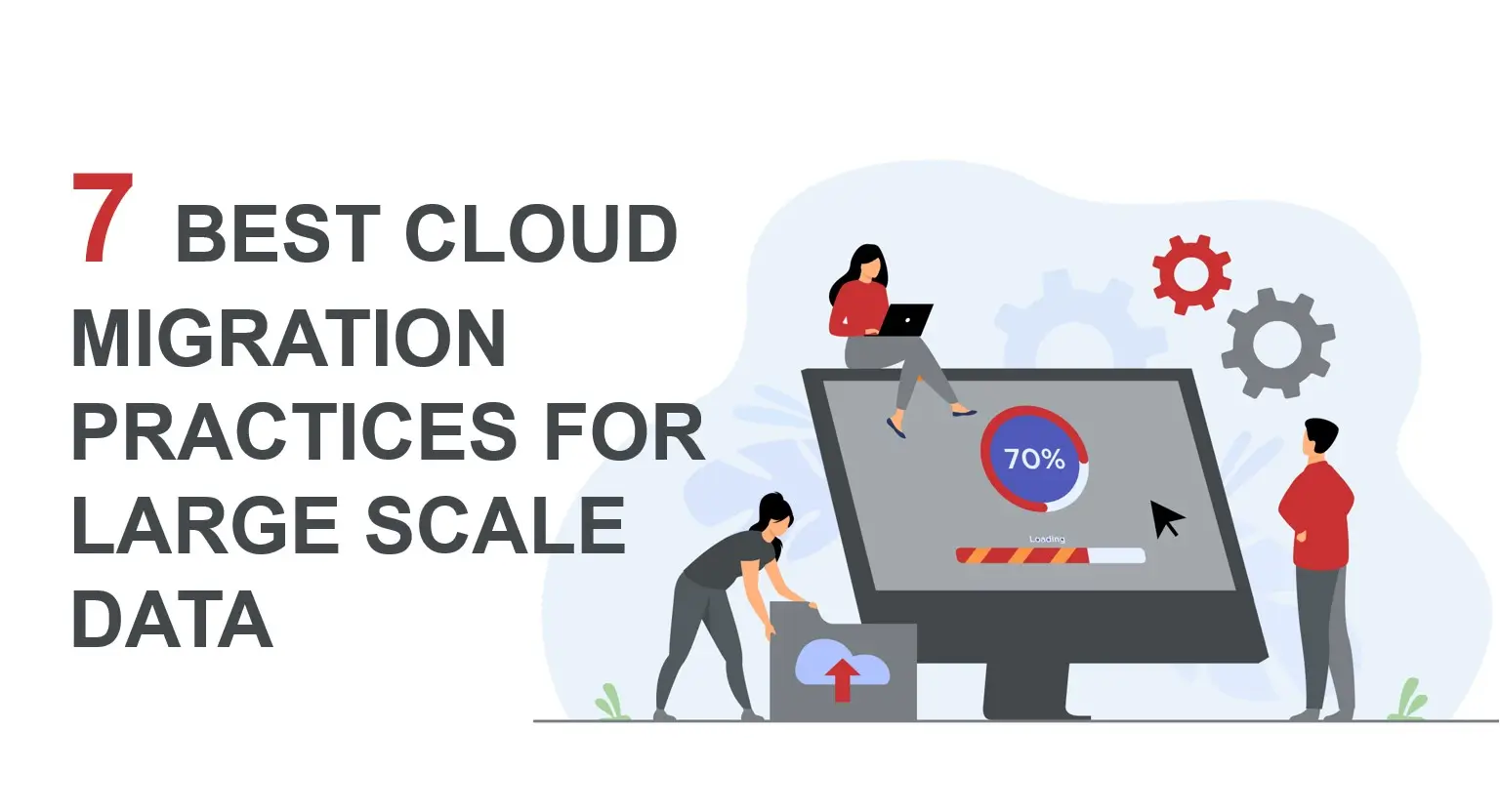7 Best Cloud Migration Practices For Large Scale Data

1 Minutes 54 Seconds | 1833 views
Listen This Blog Now!
Introduction
As businesses continue to grow and data becomes more critical to success, many are looking to move to the cloud. With cloud migration, organizations can enjoy greater scalability, cost savings, and improved data management. However, large scale data migration can be a complex and time-consuming process, and it's important to follow best practices to ensure a smooth transition. Here are seven key cloud migration practices to help you get started.
Best Cloud Migration Practices
- Assess Your Data: Before starting your cloud migration, assess the size and complexity of your data to determine the right migration strategy. You need to consider factors such as data size, network bandwidth, and data structure, among others.
- Plan Your Migration Strategy: Based on the data assessment, develop a comprehensive plan for migrating your data. This plan should include a timeline, a budget, and a risk assessment.
- Choose The Right Cloud Service Provider: Not all cloud service providers are the same. Choose a provider that can meet your specific needs and requirements. Consider factors such as security, scalability, and data management.
- Secure Your Data: Ensure that your data is secure during migration and once it's in the cloud. This involves encrypting your data, setting up firewalls, and ensuring that access is controlled.
- Test Your Migration Plan: Before migrating your data, it's important to test your migration plan to identify any potential issues. This will help you ensure a smooth transition and minimize downtime.
- Monitor Your Migration: Once you have started your migration, monitor it closely to ensure that it's proceeding as planned. This will help you identify and resolve any issues before they become major problems.
- Keep Your Data Updated: After migrating your data, it's important to keep it updated. This involves backing up your data, performing regular software updates, and monitoring your data for any changes.
Conclusion
In conclusion, cloud migration is a major undertaking, but with the right planning, it can be a successful one. By following these seven best practices, you can ensure that your large-scale data migration goes smoothly, and you can start enjoying the benefits of cloud computing.
Ready to make the move to the cloud? Let CyberNX help!
At CyberNX, we understand the complexities and challenges of large-scale data migration. Our team of experts is equipped with the knowledge and experience to ensure a seamless transition to the cloud. From data assessment and planning to implementation and monitoring, we provide a comprehensive cloud migration solution that fits your unique needs and requirements. Don't let the fear of cloud migration hold you back. Contact CyberNX today and let us help you unlock the full potential of the cloud.
Table Of Content
- Introduction
- Best Cloud Migration Practices
- Assess Your Data
- Plan Your Migration Strategy
- Choose The Right Cloud Service Provider
- Secure Your Data
- Test Your Migration Plan
- Monitor Your Migration
- Keep Your Data Updated
- Conclusion
Introduction
As businesses continue to grow and data becomes more critical to success, many are looking to move to the cloud. With cloud migration, organizations can enjoy greater scalability, cost savings, and improved data management. However, large scale data migration can be a complex and time-consuming process, and it's important to follow best practices to ensure a smooth transition. Here are seven key cloud migration practices to help you get started.
Best Cloud Migration Practices
- Assess Your Data: Before starting your cloud migration, assess the size and complexity of your data to determine the right migration strategy. You need to consider factors such as data size, network bandwidth, and data structure, among others.
- Plan Your Migration Strategy: Based on the data assessment, develop a comprehensive plan for migrating your data. This plan should include a timeline, a budget, and a risk assessment.
- Choose The Right Cloud Service Provider: Not all cloud service providers are the same. Choose a provider that can meet your specific needs and requirements. Consider factors such as security, scalability, and data management.
- Secure Your Data: Ensure that your data is secure during migration and once it's in the cloud. This involves encrypting your data, setting up firewalls, and ensuring that access is controlled.
- Test Your Migration Plan: Before migrating your data, it's important to test your migration plan to identify any potential issues. This will help you ensure a smooth transition and minimize downtime.
- Monitor Your Migration: Once you have started your migration, monitor it closely to ensure that it's proceeding as planned. This will help you identify and resolve any issues before they become major problems.
- Keep Your Data Updated: After migrating your data, it's important to keep it updated. This involves backing up your data, performing regular software updates, and monitoring your data for any changes.
Conclusion
In conclusion, cloud migration is a major undertaking, but with the right planning, it can be a successful one. By following these seven best practices, you can ensure that your large-scale data migration goes smoothly, and you can start enjoying the benefits of cloud computing.
Ready to make the move to the cloud? Let CyberNX help!
At CyberNX, we understand the complexities and challenges of large-scale data migration. Our team of experts is equipped with the knowledge and experience to ensure a seamless transition to the cloud. From data assessment and planning to implementation and monitoring, we provide a comprehensive cloud migration solution that fits your unique needs and requirements. Don't let the fear of cloud migration hold you back. Contact CyberNX today and let us help you unlock the full potential of the cloud.
Share this on: